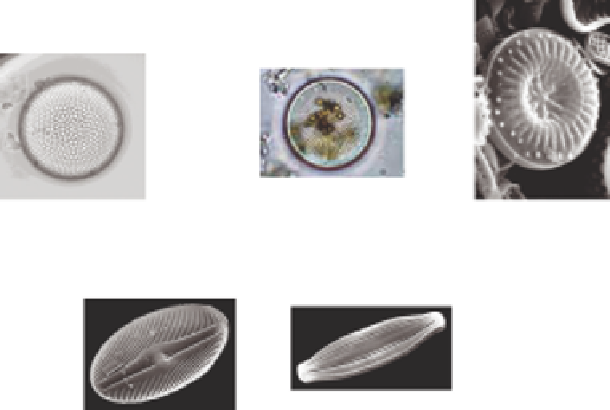Environmental Engineering Reference
In-Depth Information
Examples of centric diatoms
Coscinodiscus
spp.
Cyclotella
spp.
Actinocyclus
spp.
Examples of pennate diatoms
Navicula
spp.
Diploneis
spp.
FIGURE 15.9
Examples of diatoms. (From NOAA's Great Lakes Water Life Photo Gallery.)
often distinguished based on the shape and structure of the valves. Two major groups include
the centric diatoms (typically planktonic) with disk-shaped or cylindrical cells, and the pen-
nate diatoms (typically benthic) that exhibit bilateral symmetry (elongated) (Figure 15.9).
•
Division Dinophyta—Dinolagellates: Dinolagellates are primarily found in marine envi-
ronments although they may become abundant in freshwaters as well; they are particularly
abundant in oligotrophic lakes. One characteristic of this group is the presence of two la-
gella, which are long strands of protein groups that can be manipulated for movement. This
allows them to move within the water column to areas where light and nutrients are optimal.
•
In marine waters, summer blooms may be so dense that the water appears golden or red,
producing what is called the “red tide.” In addition, in some of these blooms, the dino-
lagellates produce a neurotoxin, which affects the muscle function in some organisms.
Humans eating ish or shellish contaminated with these neurotoxins may also be affected.
•
Division Chlorophyta—Green Algae: Green algae are an abundant, diverse, and impor-
tant group, and are considered the most closely related to higher plants. This group is
almost totally freshwater in distribution (Wetzel 2001); and includes a great diversity of
size, shape, and growth forms (single celled, colonial, ilamentous, and lagellated), most
of which are bright green, because chlorophyll is not masked by accessory pigments. They
are almost exclusively phototrophic. Some of the more common forms in the Great Lakes
are illustrated in Figure 15.10.
15.3.1.1.1.2 Bacteria (Domain: Bacteria, Kingdom: Monera, Division: Cyanobacteria)
Blue-
green algae, or Cyanobacteria, as indicated previously, are not a true algae but rather an ancient
group of bacteria. Cyanobacteria are prokaryotic organisms; they lack a nucleus and organelles
(chloroplast, mitochondria). These are also a “problem child” of the phytoplankton community, and
have been so for a long time. Cyanobacteria are believed to be the original “planet killer.” Several
billion years ago, free oxygen was rare in our atmosphere, so living organisms were mostly anaero-
bic. One of the irst organisms to use water and light for photosynthesis was the Cyanobacteria,
producing oxygen as a by-product, which was toxic to anaerobic organisms and favored the develop-
ment of aerobic organisms. And here we are.
Cyanobacteria exhibit a number of features that make them very competitive, and undesirable.
They are very productive, often dominating phytoplankton populations in lakes with high nutrient

Search WWH ::

Custom Search